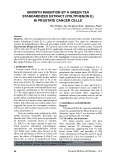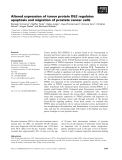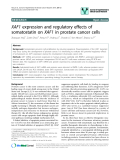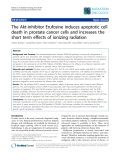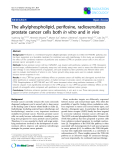
Journal of Medicine and Pharmacy - No.5
56
GROWTH INHIBITION BY A GREEN TEA
STANDARDIZED EXTRACT (POLYPHENON E)
IN PROSTATE CANCER CELLS
Phu Thi Hoa 1,Ngo Viet Quynh Tram1, Gianfranco Pintus2
(1) Hue University of Medicine and Pharmacy, Vietnam
(2) University of Sassari, Italy
Abstract
Objective: Green tea consumption has been shown to exhibit cancer-preventive activities in preclinical
studies. Polyphenon E (Poly E) is a green tea standardized extract. This study was undertaken to
examine the antiproliferative effect and pro-oxidant activity of Poly E on PC3 prostate cancer cells.
Experimental Design and results: - PC3 prostate cancer cells were used as model system. Treatment
of PC3 cells with 30 and 100 µg/ml Poly E significantly decreased cell viability and proliferation. At
all tested concentrations, Poly E elicited pro-oxidant effect at 30 and 100 µg/ml. This effect of Poly E
is consistent with the observed cytotoxicity, thus establishing a correlation between pro-oxidant activity
and the antiproliferative effect of Poly E in PC3 cells. Conclusion: Our data showed the antiproliferative
effect of Poly E and suggest Poly E-induced pro-oxidant effect involved in this activity.
Key words: Polyphenon E, pro-oxidant effect, prostate cancer cells.
1. INTRODUCTION
Prostate cancer (PCa) is one of the most
frequently diagnosed male cancer in the Western
countries and continues to represent a major
cause of cancer-related mortality, despite medical
advances. Asian-Americans seem to be at the
lowest risk for PCa [9]. About less than 10% of
PCa has been shown to be inherited suggesting that
a variety of genetic and environmental factors may
be important contributions to PCa development
[17]. The Asians appear to have the lowest risk of
developing PCa which may be due to consuming
specific dietary constituents daily over many years.
Over the last two decades many epidemiological
studies, both cohort and case-control studies, have
suggested that green tea consumption correlates
with a lower risk of certain cancers such as breast,
colon, and prostate [7].
Green tea contains many polyphenols, which
include flavanols, flavandiols, flavonoids and
phenolic acids. Most of the green tea polyphenols
are flavanols, commonly known as catechins
[1]. EGCG is the major catechin in green tea,
which possesses antioxidant, anti-mutagenic,
anti-proteolytic and anti-proliferative activity
[14]. While many studies have focused on the
effects and mechanism of EGCG on various cell
types, the effects of Polyphenon E (Poly E) on
tumor cells, as well as its mechanism of action,
have to be elucidated yet. Polyphenon E is a
well-defined pharmaceutical-grade mixture of
polyphenols that contain about 50% EGCG and
30% other catechins [2]. Since the formulation is
highly reproducible and easily prepared, Poly E
is an attractive derivative of green tea for clinical
chemoprevention trials [16].
In the present study, we show that Poly E, a
green tea standardized extract can inhibit PC3
cell growth. We also demonstrate that Poly E
can induce pro-oxidant effect, suggesting a
correlation between pro-oxidant activity and the
antiproliferative effect of Poly E in PC3 cells.
2. MATERIALS AND METHODS
Reagents
Polyphenon E (Poly E), a green tea standardized
extract was manufactured by Mitsui Norin Co. Ltd.
(Shizuoka, Japan). Poly E was dissolved in PBS
plus or cell medium with 2.5% FBS.
2.1 Cell culture and treatments
PC3 human prostate cancer cells from
ATCC (Rockville, MD) were cultured in Fk12
nutrient mixture 1X (Invitrogen, Carlsbad,
CA) respectively, supplemented with 7% fetal
bovine serum (FBS) and penicillin G (100
U/ml), streptomycin (100 μg/ml) and 0,25 μg/ml
amphotericin B. Cells were maintained at 37°C
and 5% CO2 in a humid environment.
- Corresponding author: Phu Thi Hoa, email: phuthihoa2010@gmail.com
- Received: 28/4/2014 Revised: 16/6/2014 Accepted: 25/6/2014 DOI: 10.34071/jmp.2014.1e.9





